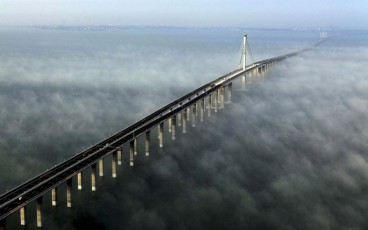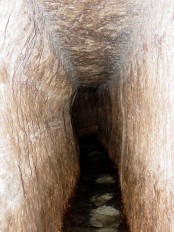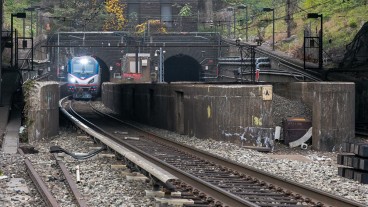Tunnel of Eupalinos

Contents [show]
- Location Description
- Project Location
- Historical Context
- Approximate Year of Completion
- Duration of construction
- Project description
- Construction details/observations
- Other significant comments
- Sources and references
- Project Id
Location Description
37°41'40.70"N, 26°55'48.37"E
Project Location
37.75516396637261LOL26.996416174806654
Historical Context
Polycrates was a tyrant who wanted to provide water for his city. “Delivering fresh water to growing populations has been an ongoing problem since ancient times. There was a copious spring at a hamlet, now known as Agiades, in a fertile valley northwest of the city, but access to this was blocked by Mount Castro. Water could have been brought around the mountain by an aqueduct, as the Romans were to do centuries later from a different source, but, aware of the dangers of a watercourse exposed to an enemy for even part of its length, Polycrates ordered a delivery system that was to be completely subterranean.” Polycrates hired a Greek engineer named Eupalinos to design the waterway. (Apostol, 2004)
Approximate Year of Completion
Sixth century B.C.E [Hughes, ?]
Duration of construction
“No one knows exactly how long it took to complete the project, but estimates range from 8 to 15 years.” (Apostol, 2004)
Project description
This water tunnel is 1,036 meters long. “It was dug through solid limestone by two separate teams advancing in a straight line from both ends, using only picks, hammers, and chisels. It averages two meters wide and two meters high (Apostol, 2004). Fig. 1 shows an inside view of the tunnel.
Fig. 1: Inside the Tunnel of Eupalinos (Source: Torben Bolhøj)

Construction details/observations
A theoretical method proposed by Hero of Alexandria five centuries after the completion of the tunnel “calls for a series of right-angled traverses around the mountain beginning at one entrance of the proposed tunnel and ending at the other, maintaining a constant elevation [see Figure 3 and 4]. Fig. 2 shows the clay gutters used to guide the water around in the tunnel.
Fig. 2: "Clay gutters like these were found in the bottom of the tunnel’s water channel. They could have been joined at right angles by L-shaped pieces, and used as leveling gutters around the mountain.” (Apostol, 2004)

Fig. 3: "At the southern end, the water channel is a staggering nine meters lower than the floor of the tunnel." (Apostol, 2004)

Fig. 4: "Hero of Alexandria's theoretical method for working out the line of a tunnel dug simultaneously from both ends." (Apostol, 2004)

Other significant comments
“Two other famous examples are the much shorter, and very sinuous, Tunnel of Hezekiah (also known as the Siloam tunnel), excavated below Jerusalem around 700 B.C., and a much longer tunnel under the English Channel completed in 1994.” (Apostol, 2004)
Sources and references
Hughes, Dan.The tunnel of eupalinos.Retrieved December 4, 2014, from http://homepages.cwi.nl/~aeb/math/samos/
Apostol, Tom. (2004). Tunnel of samos.(1), Nov. 30.
Project Id
DJP-04-14
Selected Topics
Want to read more like this?

The Longest Underwater Tunnel
Jul, 13, 2015 | NewsThe underwater tunnel is a huge project with a cost at around 36 billion US dollars, with a length t...
Banihal-Katra rail link: India's longest escape tunnel completed
Dec, 21, 2022 | NewsIndia’s longest escape tunnel, which is 12.89 km long constructed on the 111km under-construction B...
World’s longest purpose-built pedestrian and cycle tunnel is set to open in Norway soon
Mar, 09, 2023 | NewsThe world’s longest purpose-built tunnel for bicycles and pedestrians is set to open on the 15th of...
The longest railway tunnel in Nordics handed over
Nov, 23, 2022 | NewsThe 20km long Blix tunnel is the longest railway tunnel in Scandinavia and the first Norwegian rail...

Hezekiah's Tunnel (Siloam Tunnel)
Jan, 21, 2015 | EducationLocation Description 31°46'20.39"N 35°14'8.44"E Project Location 31.773750670032722LOL35.23689201538...

3 major East Coast tunnel, the Hudson Tunnel, the Howard Street Tunnel and the Chesapeake Bay Bridge Tunnel, projects move forward
Jan, 26, 2022 | NewsThree major tunnel projects that connect key transportation arteries on the East Coast are advancin...
Drilling for the 5.63-kilometer-long Učka Tunnel in Croatia has been completed
Sep, 22, 2023 | NewsIt was announced that drilling for the new 5.63-kilometer-long Učka Tunnel in Croatia has been comp...
Indian Railways’ longest electrified tunnel to change the freight transportation
Jan, 13, 2023 | NewsIndian Railways’ longest electrified tunnel has proven to be a major game changer in the country’s...

HS2 Northolt Tunnel: Celebrating the Halfway Mark
Jul, 23, 2024 | NewsHS2's Northolt Tunnel project has reached an impressive milestone, with half of the 8.4-mile twin-b...
Trending

Calculation example - Three Point Resection

Calculation example - Determine the water content within a soil sample

The history of the Golden Gate Bridge

Online Historical Database of Civil Infrastructure
Professional Examinations Preparation

Gauss's Area Calculation Formula

Calculation Examples

